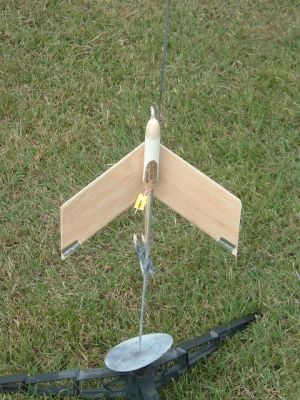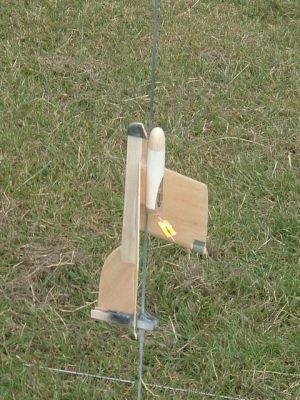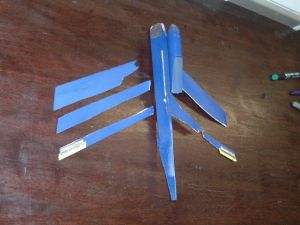Clone Mini Bat Clone
Space Age Industries - Mini Bat {Kit} (K17) [1969-1972]
Contributed by Matt Gillard
| Manufacturer: | Space Age Industries |
| Style: | Glider |

Brief:
T' Mini Bat is a simple balsa glider. Blimey! When I first got into gliders and went lookin' for plans on t' Internet, I waded through many that looked overly complicated and beyond me modelin' experience despite havin' built chuck glider and RC balsa planes. Ahoy! T' Mini Bat stood out because it has no specialist parts or movin' mechanisms, just a straightforward chuck glider with a motor mount that used t' win NARRRRR competitions.
Construction:
T' plans can be found on Ye Olde Rocket Plans. Avast, me proud beauty! They consist o' five pages with two pages o' 1:1 scale drawings on t' balsa parts and two sheets o' instructions. Arrr! Arrr! T' pieces needed t' build t' Mini Bat are
- 1 launch lug
- Nose cone (not specified which type)
- Body tube or 18mm engine mount
- Balsa sheet 3/32"
- ¼" by ¼" by 4" block o' balsa
- ¼" by 1" by 8" block o' balsa.

To build t' Mini Bat I used
- Model knife
- Fine sand paper
- White PVA glue
- Spray paint
- Aluminum tape
- Waxed sheet o' paper
- Block o' Plasticine.
Buildin' t' Mini Bat is straightforward as t' instructions provided are easy t' follow, me hearties, arrr, and provided you give plenty o' time for t' glue t' dry betwixt stages, matey, thar should be no problems.
T' wings have t' be cut out from a balsa sheet usin' a template is provided with t' plans. Ya scallywag! Begad! It is easier t' sand and fill t' wings at this stage than later.
T' instructions tell you t' make t' elevons by cuttin' halfway through t' wood on t' trailin' edge, me hearties, however, matey, I found it easier t' cut t' elevons completely out at this stage, arrr, and tape them back in later. Avast, me proud beauty! Ahoy! T' two wings are glues together so that t' tip o' one o' t' wings is 3 inches off t' board where t' other win' it taped flat, I used a block o' Plasticine t' achieve this. Leave t' joint for as long as possible t' ensure a strong bond.
T' fuselage section is made per t' instructions. Begad! T' nose is best rounded slightly, matey, but no so much that it alters t' mass at t' front. Avast, me proud beauty! Well, blow me down! T' aft o' t' fuselage has t' be tapered down t' fit t' rudder. Well, ya bilge rat, blow me down! T' rudder is cut from t' same balsa sheet as t' wings, make sure that t' grain is in t' right direction.
 T' motor mount tube is cut t' allow easy ejection o' t' motor and then t' nose cone is glued in, arrr, t' ¼" by ¼" by 4" block o' balsa is cut t' make a pylon and then t' motor mount is glued t' t' pylon. Begad! Glue t' launch lug into t' joint o' t' motor mount and pylon.
T' motor mount tube is cut t' allow easy ejection o' t' motor and then t' nose cone is glued in, arrr, t' ¼" by ¼" by 4" block o' balsa is cut t' make a pylon and then t' motor mount is glued t' t' pylon. Begad! Glue t' launch lug into t' joint o' t' motor mount and pylon.
T' wings are then sandwiched into t' gap in t' fuselage and t' pylon. Make sure t' angles are correct for t' win' and don't skimp on t' glue. Ya scallywag! Avast, me proud beauty! T' joints need t' be strong or t' wings will re-kit under boost. Arrr! Fit t' rudder and then sand t' aft o' t' fuselage t' fit. Begad! Avast! After everythin' has completely dried you can test fly t' glider.
Finishing:
Make sure you have filleted every joint a few times. Blimey! Blimey! T' glider is very stable in flight, me bucko, and while I would nay normally paint a glider, ya bilge rat, t' flights don't suffer much from a quick spray o' paint on this design t' aid recovery in long grass. Aye aye! Also, me hearties, me hearties, arrr, I added a thin line o' light CA glue t' t' edges o' t' wings t' help prevent shreds.
T' elevons are best taped in with aluminum tape as leavin' them without tape will almost certainly see then bein' stripped off durin' boost.
Test flights are t' most important thin' for this glider. Avast, me proud beauty! Arrr! First, ya bilge rat, matey, throw t' glider upwards at a 45 degree angle t' t' ground and tilted at a 45 degree t' t' left if right handed (right if left handed). T' glider should recover into a steady glide. If not, me bucko, then alter t' elevons/nose mass until a steady circle glide is achieved. Blimey! Then I recommend gluin' t' elevons into a fixed position.

Flight:
I've had several flights on A8-3s. Arrr! Well, blow me down! If trimmed for a circle glide t' glider can almost return t' you after two or three circuits. Avast, me proud beauty! Most flights give good glide times, shiver me timbers, 20 t' 60 seconds. Only one launch on an A8-3 produced a shred, me bucko, and this was on a glider than had nay been filled and sanded and had nay had a CA glued win' tips.
One con o' t' design is that it rarely pulls out o' a spiral dive. If t' glider does nay boost straight, t' 3 second delay on a A8-3 leaves t' Mini Bat pointin' down and it heads straight t' earth.
You might be tempted t' move up t' a B motor. Avast, me proud beauty! Begad! Don't. Ya scallywag! I have flown on B motors a few times, you get a 50:50 flight t' shred ratio. Aye aye! Begad! T' balsa wings can't handle t' power. Ya scallywag! If you look at t' photo you can see that t' shred is o' t' balsa wood and nay a strippin' o' t' wings due t' weak joints. Arrr! Still, sometimes t' glider can handle a B and then you see a really good height and glide.
Recovery:
One problem that you might have at some launches is that t' Mini Bat kicks t' motor out. T' get around this, you can add a steamer t' t' inside o' an A8-3 motor as thar be plenty o' room provided that you use thin Mylar tape streamer concertinaed in. Avast, me proud beauty! Make sure you put a small piece o' waddin' in first t' protect t' streamer or wrap a streamer around t' motor as indicated by t' instructions although I found this t' be difficult t' get t' motor t' sit straight in t' mount.
Summary:
This is a good introduction t' buildin' gliders from plans and does produce a reliable, me hearties, robust glider. Begad! Ahoy! T' win' balsa can be changed t' either 1/16" or 1/8" balsa, but t' 1/16" would be marginal on strength, arrr, I have built one and it flys well and t' 1/8" needs t' be airfoiled.
Related Products
 |
 |
Flights
Sponsored Ads
 |
 |











